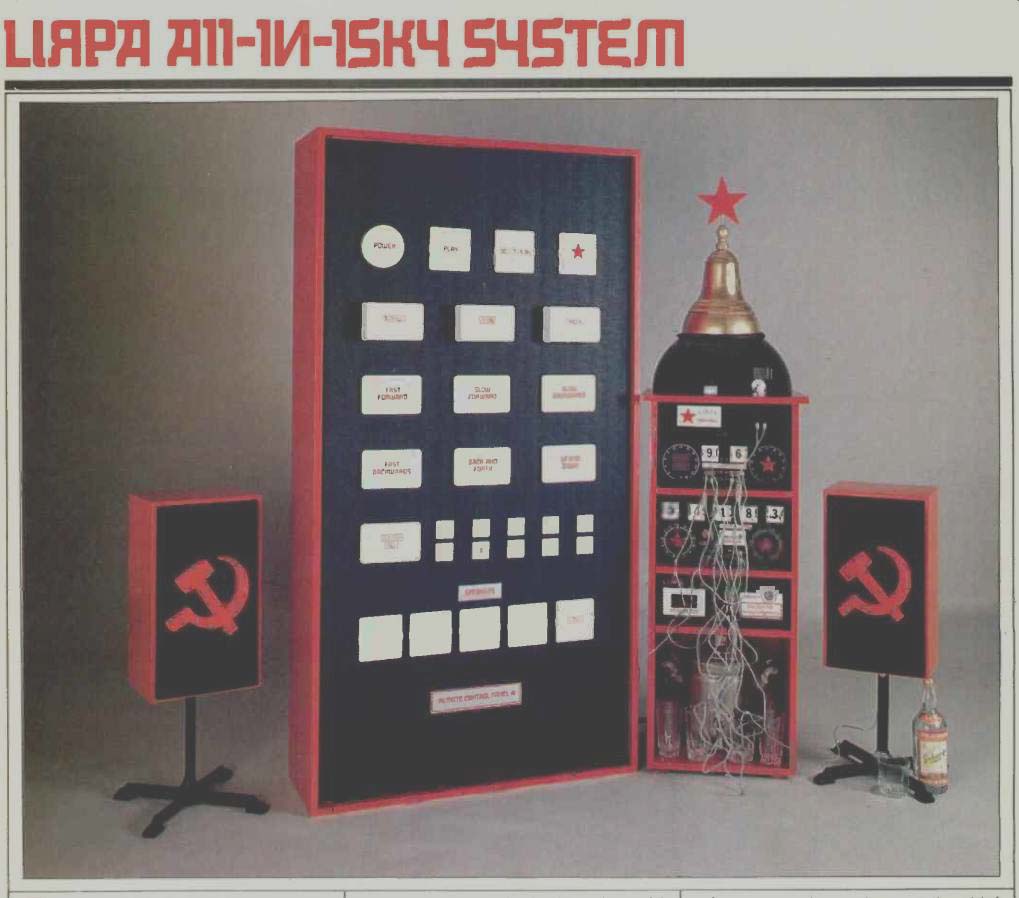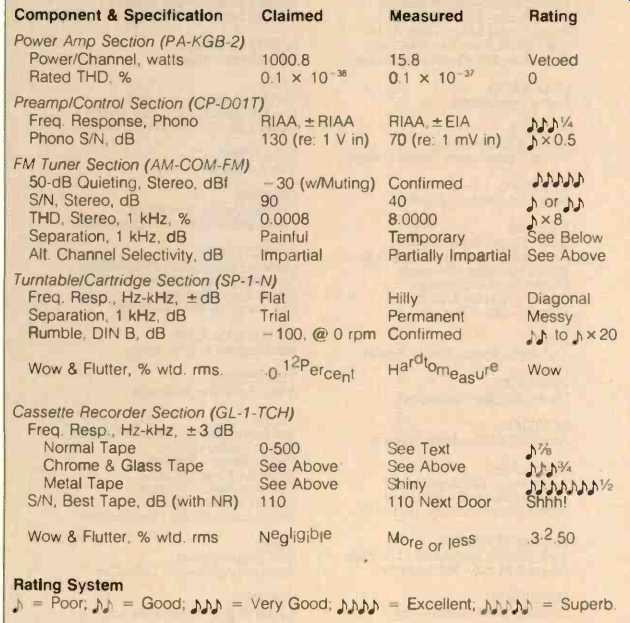
It has been some time since Professor Igor Lirpa last introduced an audio
product that he was willing to share with the rest of the world. I recently
found out why. The Professor has moved his entire research and production
facilities to the center of Moscow, and it has taken him and his associates
all this time to organize and man/woman the new headquarters.
The move was prompted by some correspondence that the good doctor received from the Justice Department, the Federal Trade Commission and the Internal Revenue Service, not to mention some special tax abatement inducements offered by the Moscow Chamber of Commerce. Examining his first one-brand system to be exported to this country, I can only say that it was worth the wait. In fact, I would have been willing to wait another year or two, if necessary.
Let's examine the cabinet first. It is constructed of Siberian Pine and finished in bright red. The turntable dust cover is in the form of a dome or spire, vaguely reminiscent of the spires of the Kremlin, which is within a stone's throw of the new Lirpa offices. Three upper shelves house the audio components.
The lower shelf is stocked with Vodka and a small electrically operated samovar for making hot tea. The samovar plugs into the amplifier output jacks, along with the speakers. When a recording of Comrade Andropov is played, enough hot air is generated to heat the tea and activate the speakers at the same time.
As everyone knows by now, the chief advantage of one-brand systems is the fact that the components are designed to work optimally with each other. This is especially true of the Lirpa. Mounted below the turntable is a four-blade fan, connected by a belt to the direct-drive motor of the platter. When playing a record, the spinning turntable causes the fan blades to revolve, thereby providing needed ventilation for the amplifier just below. The only disadvantage I could see in this arrangement is that you must keep the turntable spinning (45 rpm is preferred) even when listening to the tuner or to the tape deck, but this is a small price to pay for adequate thermal dissipation. Furthermore, the noise of the fan helps to mask tape hiss (in the case of tape deck play back) and static caused by transmitter jamming (in the case of trying to pick up shortwave broadcasts of the Voice of America). The tuner covers all frequencies from long-wave through medium wave, FM, and VHF and UHF TV. A special jack mounted prominently on the front of the tuner is labeled "Multiplex." Dr. Lirpa informs me that very soon now it will be possible to broadcast stereo over a single FM transmitter, and when that happens, the Lirpa tuner will be ready for any outboard adaptors that come along. Meanwhile, a switch labeled "Echo" provides a sort of synthesized stereo effect; whenever a high-level Politburo member addresses the nation, his words are automatically echoed by the rest of the presidium. Scientists in Moscow are said to be working on a system for AM as well as FM stereo, but because they have come up with five different systems, the project has been shelved. After all, how would the Soviet Union be able to explain to the Western world their inability to come up with a single, agreed-upon system? While the amplifier failed to deliver its rated power by a rather significant margin, it did offer many features not found in either U.S., Japanese or other European amps. Rather than suppress turn-on "thumps" with signal-impairing relay-contacts, when the switch is turned on, a fluorescent indicator lights up with the message, "GET READY FOR THE THUMP!" The thump itself follows almost immediately. As for the preamplifier, instead of hiding its less often-used controls behind hinged doors, these controls were put on the rear panel. Since this took up most of the space of the rear panel, the input and output jacks were moved to the front. To be sure, this means that there are cables draped across the front of the system but, on the positive side, should you ever have to remove this component for servicing, you won't have to reach around to the back of the unit to disconnect all those cables.
We come, now, to the cassette deck, perhaps the most ingeniously designed component of the entire system. Dr. Lirpa, being the universal man that he is, heard that there was some problem in the U.S. with people taping copyrighted programs onto cassettes.
Recognizing that any royalty collection and distribution system would be too cumbersome to implement, the Professor came up with a better idea. The GL-1-TCH cassette deck is equipped wilt a prominently positioned coin slot, not unlike those found atop most public phones. When you want to record a copyrighted program, you simply drop a few kopeks-er-quarters into the appropriate slot. This opens the cassette compartment and allows you to insert a cassette and begin recording.
Basically, this operates on the honor system, but to take care of any dissidents or hooligans who might attempt to thwart the process, a special remote-control cable plugs into your phone jack, which is tapped by .. well, you get the idea.
Speaking of remote control, the A11-1N-1SKY system is equipped with a floor-standing wireless remote-control unit. While this accessory is, admittedly, somewhat larger than the system itself, Dr. Lirpa explains this as follows: "The remote-control cabinet is where we had to mount the parts that wouldn't fit into the regular components. We didn't want to make those components so big that they wouldn't fit into the typical Moscow or New York apartment, so we reduced the size of the component cabinet and added a second cabinet for the remote-control functions and all those left-over p.c. boards and other stuff." It's a reasonable solution to a problem that other designers have never faced as realistically. In one installation of the system that Dr. Lirpa showed me, the six-foot high remote unit was mounted flush to the ceiling, so as not to take up additional floor space. A five-foot rod (optional) allows the user to reach up and poke the desired function buttons on the remote-control unit. Longer "pokers" (as they are called) are also available so that the listener can reach the remote-control cabinet from almost anywhere in a typical living/listening room. Because of its rather large size and the number of components inside, the remote-control unit is powered from an ordinary 12-volt car battery, which fits neatly inside the remote-control cabinet, out of sight. Battery recharging is easily accomplished within two or three days. (Batteries are not included; cells are, however, readily available throughout the U.S.S.R.) When I turned on the Lirpa A11-1N-1SKY, I couldn't help thinking about the trials and tribulations of its designer, Igor Lirpa. Whether the importance of this novel system from the U.S.S.R. will reduce tensions between our two countries (by giving us something other than nuclear weapons to get angry about) is impossible to tell at this early juncture. One thing is perfectly clear about Lirpa, though. You can't keep a good man down-no matter how hard you try!
-Lenin Feidmanovich
------------------
ONE-BRAND SYSTEM RATINGS
Manufacturer: Lirpa Mfg. Co. Ltd., Inc., S.A.
Model: A11-1N-1SKY
Company Address: Leningradsky prospect 47, Moscow 125167, U.S.S.R
Cabinet Dimensions: 0.23 rods H x 7 hands W 'x 0.3 chains D. Price: 900 rubles (at black-market exchange rate, $54.95).
For literature, use a library.

General Comments (Actually made by a Lieutenant General)
Power Amplifier: Sounded best when playing music of Shostakovich, Borodin and Stravinsky. Deteriorates badly when reproducing decadent Western rock music. Distortion tends to rise when played in warmer-than-Siberian environment.
Turntable & Cartridge: Plays best when switched to a higher number of revolutions.
Cartridge will appeal to the lower masses; as for pickup, could benefit from arm's reduction (in mass, that is). Speakers: Seemed flat enough, but I detected some radiation all the way up to the microwave region.
Overall Rating: I give it a unanimous vote of approval, ♩ ♩ ♩ (nobody's perfect!).
-----------------
=============
(Adapted from Audio magazine, Apr. 1983)
Also see:
Kenwood Spectrum 70 (One Brand System) (Jul. 1982)
= = = =